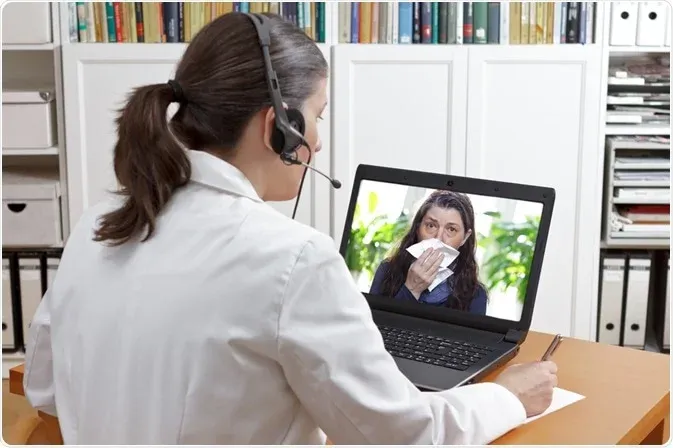Computer Vision in Telemedicine for Enhanced Healthcare Delivery

Table of Contents
- Introduction
- Why Computer Vision?
- Model Building
- Challenges
- How Labellerr Helps
- Frequently Asked Questions
Introduction
Mr. Rahman and his daughter Aisha live in a rural village.
Mr. Rahman, who suffers from hypertension and his condition needs frequent monitoring and medication changes.
There being no nearby hospital, and every journey to the city mean missing a day of work and paying fees they couldn't afford.
Feeling helpless, Aisha turned to technology for aid.
She learned about telemedicine and decided to pursue it further.
She booked an appointment for her father with Dr. Khan, a well-known cardiologist, who attentively listened to Mr. Rahman's medical history, symptoms, and worries.
Dr. Khan accompanied Mr. Rahman through a number of easy tests via video call, including monitoring his blood pressure and heart rate with a telemedicine service-provided digital monitor.
Dr. Khan provided personalised advice on medication adherence, lifestyle modifications, and dietary changes to effectively treat hypertension.
As the days passed into weeks, Aisha noted a significant improvement in her father's health.
Mr. Rahman was able to regain control of his health thanks to telemedicine, which eliminated the need for frequent travels to faraway hospitals.
Futhermore, here are some stats!
The AMA reports that telemedicine usage grew by more than 1,000% during the COVID-19 pandemic.
A research published in the Journal of Medical Internet Research discovered that telemedicine reduced hospital admissions by 39% and readmissions by 66%.
In a poll performed by the American Telemedicine Association, 83% of patients showed satisfaction with telemedicine consultations, mentioning ease and accessibility as important parameter.
The Global industry Insights research estimates that the telemedicine industry would approach $175 billion by 2026, owing to technological developments and rising demand for remote healthcare services.
Let's look closer into the major impacts of the telemedicine.
Why Computer Vision?

Computer vision is critical in telemedicine because it has the potential to transform healthcare delivery.
It allows for remote medical picture analysis, vital sign monitoring, and even wound assessment via AI algorithms.
From detecting illnesses via telepathology to improving visual teleconsultations.
Computer vision enables healthcare providers to provide high-quality treatment remotely, bridging the gap between patients and medical experts with efficiency and precision.
Some use cases -
- Remote Analysis of Medical pictures: Computer vision algorithms analyse medical pictures such as X-rays and CT scans remotely, resulting in faster and more accurate diagnoses.
- Monitoring Vital Signs: Computer vision monitors vital signs via live video streams or wearable devices, identifying changes that could suggest health problems.
- Telepathology: Computer vision analyses digital images of tissue samples, allowing pathologists to diagnose disorders without physically transporting the tissue samples
Model Building
Data Collection
- Gather a diverse dataset of wound images, including various types of wounds (e.g., diabetic ulcers, pressure sores, surgical incisions) and different stages of healing.
- Ensure that the dataset includes annotations or labels indicating wound characteristics such as size, depth, color, and presence of infection.
- If dataset isn't annotated, use specialized annotation software or platforms to streamline and maintain consistency.
- Either a manual process or specialist annotation tools like Labellerr can be used for this.
Data Preprocessing
- Resize and standardize images to a consistent resolution.
- Normalize pixel values to improve model convergence.
- Augment the dataset with techniques like rotation, flipping, and brightness adjustments to increase variability and robustness.
Model Selection
- Choose a suitable deep learning architecture for image classification and segmentation tasks, such as convolutional neural networks (CNNs).
- Consider pre-trained models like ResNet, VGG, or DenseNet, which have been trained on large-scale image datasets and can be fine-tuned for the specific task of wound assessment.
Model Training
- Split the dataset into training, validation, and test sets (e.g., 70-15-15 split).
- Train the selected model using the training data, optimizing the loss function with techniques like stochastic gradient descent (SGD) or Adam optimization.
- Monitor performance metrics such as accuracy, precision, recall, and F1-score on the validation set to prevent overfitting and guide hyperparameter tuning.
Model Evaluation
- Evaluate the trained model on the test set to assess its generalization performance and ability to accurately classify and characterize unseen wound images.
- Utilize domain-specific metrics to evaluate the model's performance in wound assessment tasks, such as Jaccard similarity index for segmentation accuracy.
Model Deployment
- Integrate the trained model into a telemedicine platform or application, allowing users (patients or healthcare providers) to upload wound images and receive automated assessments and recommendations.
- Ensure compliance with relevant healthcare regulations regarding patient data privacy and security during model deployment and usage.
Continuous Improvement
- Collect feedback from users and healthcare professionals to identify areas for model refinement and enhancement.
- Continuously update the model based on new data, emerging wound assessment techniques, and user feedback to improve accuracy and usability over time.
Scalability and Accessibility
- Design the model architecture and deployment infrastructure to handle varying levels of user traffic and data volume as the telemedicine platform grows.
- Ensure accessibility across different devices and network conditions to support seamless usage by patients and healthcare providers.
Challenges
Implementing computer vision in telemedicine presents several challenges that must be addressed to ensure effective and reliable deployment:
- Data Quality and Quantity: Obtaining diverse, well-labeled datasets for training models.
- Interpretability: Ensuring transparency in model decisions for trust and understanding.
- Data Privacy and Security: Protecting sensitive patient information in compliance with regulations.
- Technical Infrastructure: Maintaining robust computing resources and network infrastructure.
- Integration: Seamlessly integrating computer vision solutions with existing healthcare systems.
- Bias and Fairness: Mitigating biases in model predictions to ensure equity.
- Regulatory Compliance: Adhering to healthcare regulations and standards.User Acceptance: Addressing user concerns and fostering adoption of new technologies.
How Labellerr Helps

Imagine you have lots of pictures and videos, and you want the computer to learn what is in each of them. Labellerr makes this easy!
Here's how it works:
(i) Connect your pictures and videos: Labellerr can take your pictures and videos from places like AWS, GCP, or Azure and put them in one easy-to-use platform.
(ii) Create and manage projects: Labellerr helps you organize your work. You can tell it what to focus on, like wounds in pictures.
(iii) Labeling engine: Labellerr has a great labeling engine. It helps you mark and describe things in the pictures, like wounds.
It can do this super fast, saving a lot of time and money.
(iv) Smart quality check: Labellerr also checks if the labels (like wounds) are correct.
It does this using its smart brain and the information it learned from your labeled pictures.
(v) Connect to AI engines: Once Labellerr finishes, you can use what it learned with other computer programs to make them smarter in recognizing wounds.
You can export the information in different formats like CSV or JSON.
So, Labellerr is a platform that helps you teach computers to recognize faces easily and quickly!
Computer vision has the potential to revolutionise telemedicine with careful planning, teamwork, and commitment to best practices, allowing patients throughout the world to get more personalised, efficient, and accessible care.
Frequently Asked Questions
Q1.How is computer vision used in healthcare?
Healthcare professionals utilise computer vision to analyse medical images, monitor patient conditions, aid with surgical procedures, and automate administrative duties.
It aids in duties such as illness diagnosis using X-rays and MRIs, monitoring patient movements and vital signs, directing surgical instruments during procedures, and managing medical records using image recognition and classification.
Q2.What role do computers play in telemedicine?
To address the communication requirements of telemedicine applications, we offer the notion of a computer communication network that may deliver multipoint-to-multipoint communication while maintaining a simple link with its customers.
Q3.What role does telemedicine play in digital health?
Telemedicine uses modern communication and information technologies to provide expert-based healthcare to understaffed remote regions, as well as cutting-edge emergency care.

Simplify Your Data Annotation Workflow With Proven Strategies
.png)


